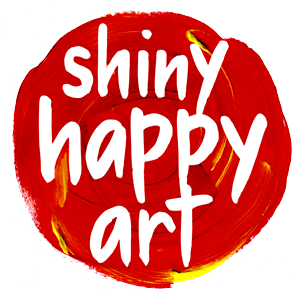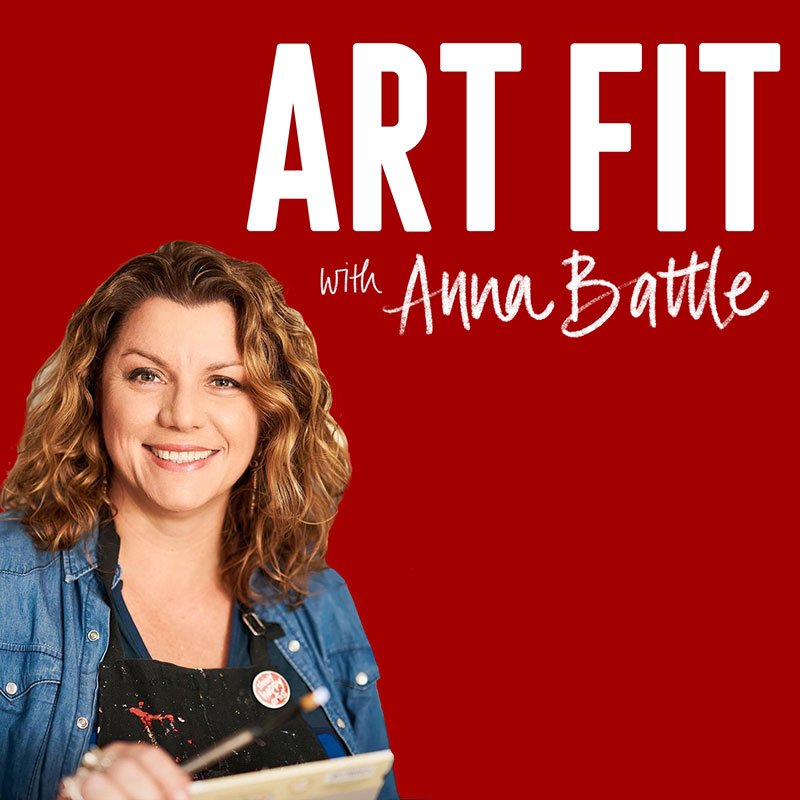Start with an understanding of the primary colours – experience them – and you’re building skills that you’ll use in every single sketch or painting.
Start by ‘really seeing’ but know there is a time when you can step away from your reference and add to your sketch simply as a work of art.
Transcript
This is episode 11 of the Art Fit Podcast. Hello, I’m Anna Battle, Shiny Happy Artist and your host of the Art Fit Podcast. Now, just as physical fitness is good for your body, Art Fitness is good for your mind. And you don’t need to be an Olympics level professional artist to benefit from Art Fitness. But what is the point? How do you actually do it? How do you fit it all in? Well, I’m on a mission to help you get Art Fit.
This podcast is brought to you by my Shiny Happy Art Club. I send you a brand new high quality guided Paint Along each month, in acrylic and watercolour, as part of a lovely group of art friends from around the world. So, you can become a Shiny Happy Artist and get Art Fit.
Now today, I’m going to share just a little that very important tip. Actually, I think there’s two of them that I want to share with you today, and it’s about adding more than one colour. So in the old days, when you are perhaps colouring in a colouring book, did you just go, okay, the sky is blue, and colour it in blue; the grass is green, and colour it in green. This is a red flower, colour it in red. It’s very likely that that is the case. So now, I’m going to encourage you to open your eyes and really see the colours in things. And at the very least, add at least one extra colour when you go in and paint or draw something. So when I’m out and about, I like having a small kit with me, and I usually take 3 coloured pencils, the 3 primary colours; blue, red and yellow.
And I do find myself adding yellow to most things at the end. If you’ve painted or watched me paint online at any opportunity, I will say, it’s time to add some yellow; it’s that’s magical zinger colour. So I often add yellow. But if you worry about perhaps going in with watercolour or any paint, and making a mud colour, you’ve probably done that before. That’s because all 3 primary colours are in that mix. So, you’ve mixed a bit of red, yellow, and blue in that mix. Now, of course, red and yellow make orange. So, if I get any blue mix with orange, I’m going to get that muddy, dark colour. Purple is made of red and blue. So if I add yellow to that, in any way, and this could be by adding orange or something with yellow in it, once again, I’ll get mud.
So, the safest way to add a second colour, whether it’s in paint or in pencil, and wanting it to look good, is to go with an analogous colour scheme. And when I say analogous, it’s these are the colours that are next to each other on the colour wheel. So, yellow has orange on one side and red on the other. So, orange. Yes, it does has red and yellow. Of course, it does. So those colours, all together, will not make mud because there’s no blue in there. It’s just those two primaries, red and yellow make orange; and that’s all there is to it. You could also pop some pink in there because in pink, there’s no blue. And whatever colours, like shades of orange or yellow will work in there as well, and you will not get mud. By the same token, if you’re painting a blue coffee cup, you might add a bit of purple or add a bit of green. But you wouldn’t add purple and green because purple’s got blue and red, green has blue and yellow. And then, put them all together and you’ve got all three primaries, so you’ll get mud.
So, when you’re just starting off, when I say add some colour to a space that you are adding colour to your sketch. And colour really does turn a drawing into an art work, I find. I mean, there’s a lot of way drawing is art, most certainly, but just to lift it in your own, like impress yourself steaks, adding a bit of colour can be fun. But when you’re colouring in, say, a yellow flower, I’d say just add a bit of orange in there as well, maybe a bit of red, and you won’t regret it. if you do regret it, it slightly differently next time. And with the sky, what colour really is the sky? It’s often lighter at the horizon line. If you look out to the horizon, the horizon is the farthest, sort of, if you’re looking at it long at the ocean in particular, the farthest way of like, the longest distance away from you is on the horizon line; and that will often be lighter, okay? Depending on the weather, but it’s lighter at the horizon line. It goes darker, when you go look up to the sky above you. But do notice, because of course, this sky changes as the sunsets and the sun rises. But these are things that you can start noticing, when you are looking through the eyes of an artist, just thinking, “Okay, this thing is red, what other colours can I add?” And adding that second colour is a terrific way of impressing yourself.
So, don’t cover up the whole thing that’s already there though. So, if you have painted the whole thing in yellow, leave some of that yellow still showing through, and it will really dance on the page. But multicolours are really more interesting. Your sky doesn’t have to be totally blue; it could have other colours in it as well. This is a lovely children’s book by the author of the dot, I think. And it’s about a child who runs out of blue paint, but still has to paint the sky. And on her way home from school that day, thinking about “how am I going to paint the sky when I have no blue paint?” she notices all the different colours of the sky. So, now is the time to open up your eyes and really see. This is a true gift of becoming Art Fit; this ability to really see things and notice things. And just starting with those 2 colours is a really good way to begin. And believe me, it doesn’t end there. When you’re adding shadows as well, sort of, don’t think that the shadows are black; there might be colours in those, too. That is a subject for another time. But start looking and noticing the colours, and you might just see that you are impressing yourself more with your art work because you’re able to include those too. Okay. So, let’s go get Art Fit with more than one colour, like more than one exercise. So, we’re stretching a whole bunch of different muscles, but more than one colour is a terrific way to go on your journey to Art Fitness.
So, you want to get Art Fit? We’ll find out when the doors to the Shiny Happy Art Club open next. There are 24 online Paint Alongs to choose from when you join, so you’ll definitely find something you love. And now, there are also $15 and $25 subscription options. So, go to www.shinyhappyart.com to pop your name on the waiting list. I look forward to painting with you in the Shiny Happy Art Club. And until then, I’ll be back in your ears with the next episode of the Art Fit Podcast.



